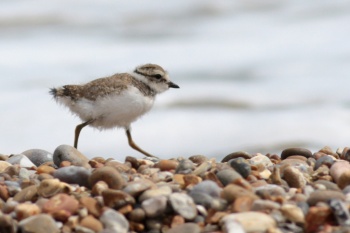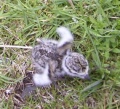(Taxonomy amended. References updated) |
(→External Links: New Video search created) |
||
| (8 intermediate revisions by 4 users not shown) | |||
| Line 1: | Line 1: | ||
| − | [[Image:Common_Ringed_Plover.jpg|thumb|450px|right|Photo by {{user|peteee23|peteee23}}<br />Point of Ayre, [[Isle of Man]]]] | + | [[Image:Common_Ringed_Plover.jpg|thumb|450px|right|Photo © by {{user|peteee23|peteee23}}<br />Point of Ayre, [[Isle of Man]]]] |
;[[:Category:Charadrius|Charadrius]] hiaticula | ;[[:Category:Charadrius|Charadrius]] hiaticula | ||
==Identification== | ==Identification== | ||
| − | [[Image:Common_Ringed_Plover_winter_by_Karim_Madoya.jpg|thumb|350px|right|Photo by {{user|Karim+Madoya|Karim Madoya}}<br />Kota Kinabalu, [[Malaysia]], November 2011]] | + | [[Image:Common_Ringed_Plover_winter_by_Karim_Madoya.jpg|thumb|350px|right|Photo © by {{user|Karim+Madoya|Karim Madoya}}<br />Kota Kinabalu, [[Malaysia]], November 2011]] |
| − | 18–20 cm ( | + | Length 18–20 cm (7–7¾ in), wingspan 47–57, weight 42–78 g<br /> |
| − | Has a distinctive bold black and white pattern on the head, short orange bill with black tip and orange legs. The | + | A medium-small plover. Has a distinctive bold black and white pattern on the head, black breast band, short orange bill with a black tip, and orange legs. The sandy brown upperparts blend well with a variety of shingle and sand colours, so that a sitting bird is often unnoticed. |
In winter, the legs usually becomes a little duller, the bill becomes mostly or all black, and the black in head and neck markings becomes browner and less distinct. | In winter, the legs usually becomes a little duller, the bill becomes mostly or all black, and the black in head and neck markings becomes browner and less distinct. | ||
| Line 10: | Line 10: | ||
Immatures are similar but with many feathers having white edgings giving a scaly impression. | Immatures are similar but with many feathers having white edgings giving a scaly impression. | ||
====Similar species==== | ====Similar species==== | ||
| − | [[Semipalmated Plover]] is closest, [[Little Ringed Plover]] the more common similar species in [[Europe]] | + | [[Semipalmated Plover]] is closest, differing in having vestigial webs between the toes, a shorter white supercilium, and a different call note. [[Little Ringed Plover]], the more common similar species in [[Europe]], differs in being smaller, with a narrower breast band, no white wingbar, a yellow eye ring, dull pinkish legs, and slightly paler brown upperparts. |
| + | |||
==Distribution== | ==Distribution== | ||
| − | [[Image:6M0A6937 1-bf.jpg|thumb|350px|right|Fledgling<br />Photo by | + | [[Image:6M0A6937 1-bf.jpg|thumb|350px|right|Fledgling<br />Photo © by the late '''[https://www.birdforum.net/gallery/showgallery.php/ppuser/50827/cat/500 Mahsleb]'''<br />[[Minsmere]], [[Suffolk]], June 2017]] |
| − | Mainly Old World, marginal in North America: breeding from northeast [[Canada]] and [[Greenland]] to [[Europe]] ( | + | Mainly Old World, marginal in North America: breeding from northeast [[Canada]] and [[Greenland]] to [[Europe]] (the northern half, including [[Britain]]) and northern [[Asia]], wintering mainly in western and southern Europe, [[Africa]], and southwestern Asia; small numbers also wintering in southeast Asia and [[Australia]]. Populations exhibit [[Dictionary_G-L#L|leapfrog migration]], with the northernmost breeding birds (e.g. arctic [[Scandinavia]]) migrating the furthest south as far as [[South Africa]], while birds breeding at the southern edge of the breeding range (e.g. Britain) only migrate short distances if at all. Vagrant to southern [[Canada]], [[USA]], the [[Caribbean]], and [[New Zealand]]. |
==Taxonomy== | ==Taxonomy== | ||
| + | Closely related to [[Semipalmated Plover]]; the two have been considered conspecific by some in the past. | ||
====Subspecies==== | ====Subspecies==== | ||
| − | [[Image: | + | [[Image:7D2 1916 b b 900.jpg|thumb|350px|right|Photo © by {{user|Joe52|Joe52}}<br />Bournemouth, [[Dorset]], February 2018]] |
| − | + | Two<sup>[[#References|1]]</sup> or three<sup>[[#References|2]]</sup> subspecies are accepted; differences are clinal making subspecific allocation difficult in some cases: | |
| − | *''C. h. | + | *''C. h. psammodromus'' |
| − | :*Breeds north-eastern arctic [[Canada]], [[Greenland]], [[Iceland]], Spitsbergen, and southern [[ | + | :*Intermediate between ''C. h. hiaticula'' and ''C. h. tundrae''. Breeds north-eastern arctic [[Canada]], [[Greenland]], [[Iceland]], Spitsbergen; primarily winters western [[Africa]]; included in ''C. h. hiaticula'' by some authorities. |
| − | *''C. h. tundrae'' | + | *''C. h. hiaticula'' |
| − | :*Breeds northern Scandanavia to eastern [[Siberia]]; winters | + | :*Large, with paler brown upperparts. Breeds [[Britain]], [[Ireland]], and southern [[Scandinavia]] south to northern [[France]]; resident or short-distance migrant to western and southern Europe and north Africa. |
| + | *''C. h. tundrae'' | ||
| + | :*Small, with darker brown upperparts. Breeds northern Scandanavia to eastern [[Siberia]]; winters Africa to the Caspian Sea and southwest [[Asia]], with small numbers southeast to Australia. | ||
==Habitat== | ==Habitat== | ||
| − | Mostly seen at the coast, but also found inland, wherever there is water with sandy or gravelly margins, e.g. gravel pits, reservoirs and in the tundra. | + | Mostly seen at the coast, but also found inland, wherever there is water with sandy or gravelly margins, e.g. gravel pits, reservoirs, and in the tundra. |
==Behaviour== | ==Behaviour== | ||
Ringed Plover can be almost impossible to see with the naked eye when on shingle beaches - one of its favourite habitats. Its movement, flight or plaintive call almost always reveal its presence, however. | Ringed Plover can be almost impossible to see with the naked eye when on shingle beaches - one of its favourite habitats. Its movement, flight or plaintive call almost always reveal its presence, however. | ||
| Line 40: | Line 44: | ||
'''Call''': melodic ''too-li'', ''coo-eep'' or ''queeo'' | '''Call''': melodic ''too-li'', ''coo-eep'' or ''queeo'' | ||
| − | + | {{ Audio|Charadrius hiaticula (song).mp3 }} | |
| − | + | ||
==Gallery== | ==Gallery== | ||
Click on photo for larger image | Click on photo for larger image | ||
<gallery> | <gallery> | ||
| − | Image:R_Plover_chick_2_small.jpg|Photo by {{user|Benderloch|Benderloch}} | + | Image:R_Plover_chick_2_small.jpg|Photo © by {{user|Benderloch|Benderloch}} |
| − | Image:R_Plover_chick_small.jpg|Photo by {{user|Benderloch|Benderloch}} | + | Image:R_Plover_chick_small.jpg|Photo © by {{user|Benderloch|Benderloch}} |
<!--EDITORS: These two images do not appear in the Gallery--> | <!--EDITORS: These two images do not appear in the Gallery--> | ||
</gallery> | </gallery> | ||
==References== | ==References== | ||
| − | #{{Ref- | + | #{{Ref-Clements6thAug17}}#{{Ref-GillDonsker17V7.2}}#Collins Pocket Guide to British Birds 1966 |
#Collins Field Guide 5th Edition ISBN 0 00 219900 9 | #Collins Field Guide 5th Edition ISBN 0 00 219900 9 | ||
{{ref}} | {{ref}} | ||
==External Links== | ==External Links== | ||
| − | {{GSearch|Charadrius | + | {{GSearch|"Charadrius hiaticula" {{!}} "Common Ringed Plover"}} |
| + | <br /> | ||
| + | {{VSearch|"Charadrius hiaticula" {{!}} "Common Ringed Plover"}} | ||
| + | {{GS-checked}} | ||
| + | <br /> | ||
<br /> | <br /> | ||
| − | |||
| − | [[Category:Birds]][[Category:Charadrius]][[Category:Bird Songs]][[Category:Videos]] | + | [[Category:Birds]] [[Category:Charadrius]] [[Category:Bird Songs]] [[Category:Videos]] |
Latest revision as of 00:02, 15 February 2023
- Charadrius hiaticula
Identification
Length 18–20 cm (7–7¾ in), wingspan 47–57, weight 42–78 g
A medium-small plover. Has a distinctive bold black and white pattern on the head, black breast band, short orange bill with a black tip, and orange legs. The sandy brown upperparts blend well with a variety of shingle and sand colours, so that a sitting bird is often unnoticed.
In winter, the legs usually becomes a little duller, the bill becomes mostly or all black, and the black in head and neck markings becomes browner and less distinct.
Immatures are similar but with many feathers having white edgings giving a scaly impression.
Similar species
Semipalmated Plover is closest, differing in having vestigial webs between the toes, a shorter white supercilium, and a different call note. Little Ringed Plover, the more common similar species in Europe, differs in being smaller, with a narrower breast band, no white wingbar, a yellow eye ring, dull pinkish legs, and slightly paler brown upperparts.
Distribution
Mainly Old World, marginal in North America: breeding from northeast Canada and Greenland to Europe (the northern half, including Britain) and northern Asia, wintering mainly in western and southern Europe, Africa, and southwestern Asia; small numbers also wintering in southeast Asia and Australia. Populations exhibit leapfrog migration, with the northernmost breeding birds (e.g. arctic Scandinavia) migrating the furthest south as far as South Africa, while birds breeding at the southern edge of the breeding range (e.g. Britain) only migrate short distances if at all. Vagrant to southern Canada, USA, the Caribbean, and New Zealand.
Taxonomy
Closely related to Semipalmated Plover; the two have been considered conspecific by some in the past.
Subspecies
Two1 or three2 subspecies are accepted; differences are clinal making subspecific allocation difficult in some cases:
- C. h. psammodromus
- C. h. hiaticula
- Large, with paler brown upperparts. Breeds Britain, Ireland, and southern Scandinavia south to northern France; resident or short-distance migrant to western and southern Europe and north Africa.
- C. h. tundrae
Habitat
Mostly seen at the coast, but also found inland, wherever there is water with sandy or gravelly margins, e.g. gravel pits, reservoirs, and in the tundra.
Behaviour
Ringed Plover can be almost impossible to see with the naked eye when on shingle beaches - one of its favourite habitats. Its movement, flight or plaintive call almost always reveal its presence, however.
Diet
The short bill is used to forage along the low water mark and amongst pebbles and drift seaweed. Sand hoppers and insects are favoured prey.
Breeding
The eggs are laid in a depression with no nest material at all, often just above the strandline, and may be inundated by exceptionally high tides. One parent sits on the nest while the other forages nearby. Disturbed birds will wait until they feel safe, then one will run up the shore to the nest.
Once hatched, the chicks are soon on the move, exploring their surroundings (see images of 2 ringed chicks). When danger threatens, a call from a parent causes them to freeze and sit tight until the parent calls the 'all clear'. Chicks are brooded beneath parents when conditions are cold or wet, but are left to find their own food. Like other wader chicks, their legs and feet appear oversized compared with the body and it takes several weeks before their proportions resemble those of the adult.
Adults will defend the young against predators 3-4 times their size, e.g. Herring Gulls; they will also perform a broken wing display to lead predators away from nests or chicks.
Vocalisation
Call: melodic too-li, coo-eep or queeo
Gallery
Click on photo for larger image
Photo © by Benderloch
Photo © by Benderloch
References
- Clements, J. F., T. S. Schulenberg, M. J. Iliff, D. Roberson, T. A. Fredericks, B. L. Sullivan, and C. L. Wood. 2017. The eBird/Clements checklist of birds of the world: v2017, with updates to August 2017. Downloaded from http://www.birds.cornell.edu/clementschecklist/download/
- Gill, F and D Donsker (Eds). 2017. IOC World Bird Names (version 7.2). Available at http://www.worldbirdnames.org/.
- Collins Pocket Guide to British Birds 1966
- Collins Field Guide 5th Edition ISBN 0 00 219900 9
Recommended Citation
- BirdForum Opus contributors. (2024) Common Ringed Plover. In: BirdForum, the forum for wild birds and birding. Retrieved 2 May 2024 from https://www.birdforum.net/opus/Common_Ringed_Plover
External Links
GSearch checked for 2020 platform.









